Cooling
For colocation spaces in data centers, various cooling strategies help to:
- Direct hot exhaust air away from electronic equipment.
- Direct cooled air to electronic equipment.
- Reduce or eliminate hot spots that can lead to equipment overheating and failure.
High-density Cooling Solutions at Equinix
Liquid Cooling
The Direct-to-Chip method provides the following:
- Most efficient heat transfer
- True liquid cooling
- Enables highest power densities
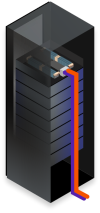
Augmented Air Cooling
Rear-door heat exchangers provide the following:
- Enhanced air cooling
- Does not require server-level retrofit
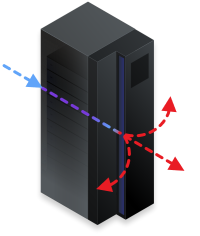
In-row coolers provide the following:
- Enhanced air cooling
- Does not require server-level retrofit
- Only available in cage environments
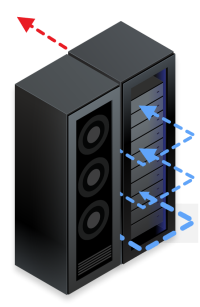
Air Containment
For your colocation space, Equinix uses air containment strategies in all data centers to:
- Direct cooled air to your equipment.
- Reduce or eliminate hot spots that can lead to equipment overheating and failure.
- Maximize the energy efficient operation of the cooling systems.
Each cabinet has a specified cold side and a specified hot side. It's important that your equipment is installed in line with the conditioned airflow, as follows:
- The air inlet of the hardware must be at the cold side of the cabinet.
AND
- The outlet (warm air) of the hardware must be ejected on the hot side of the cabinet.
Installing your equipment in the opposite direction could lead to cooling problems and malfunctioning of equipment. In the case of incorrect installation, Equinix’ service guarantees are invalidated. When we become aware of these issues, Equinix sends you a policy violation notification requesting that you correct the installation.
For more information, refer to our Customer installation Guidelines and our Data Center Design page.
Benefits of Air Containment
- Increases the operating efficiency of the data center (thereby reducing its carbon footprint).
- Reduces energy usage, water usage, pollutants, and utility costs.
- Optimizes the operating performance/uptime of your equipment.
- Extends the lifespan of your hardware.
- Allows higher density of rack equipment.
- Compliance with local building codes.
Air Containment Methods
The most common air containment methods used at Equinix data centers are illustrated below.
The red arrows indicate hot air; the blue arrows indicate cold air.

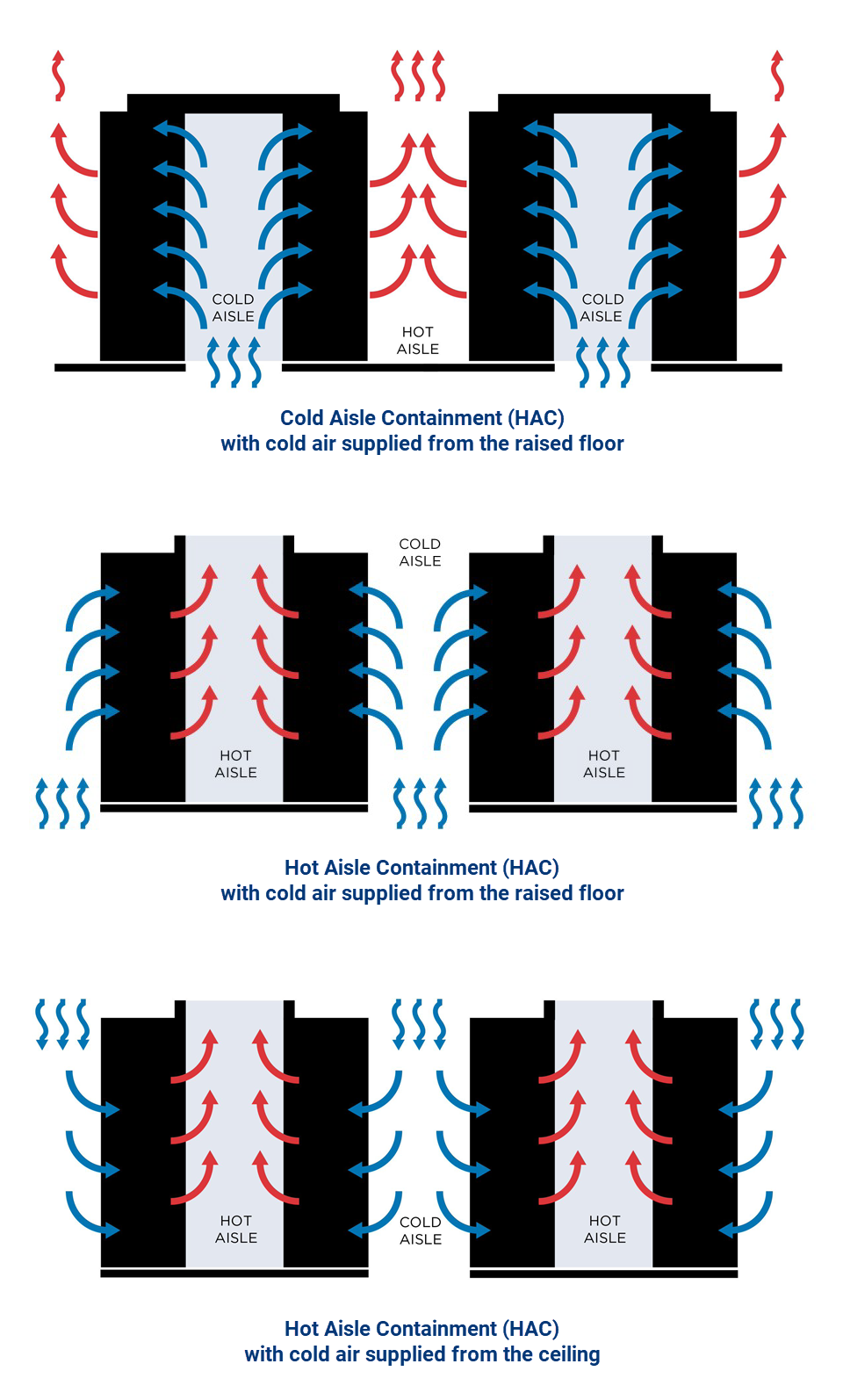
Air containment methods vary by IBX, depending on the IBX configuration, the local building code requirements, and the local fire safety regulations.
Air Containment Components
Equinix charges for brush strips, rackseal foam, and switch duct accessories. Other components are provided and installed by Equinix at no additional cost to customers (in most cases).
These components are used to keep the cooled air supply separate from the hot exhaust air from equipment. Click the image below for component details:
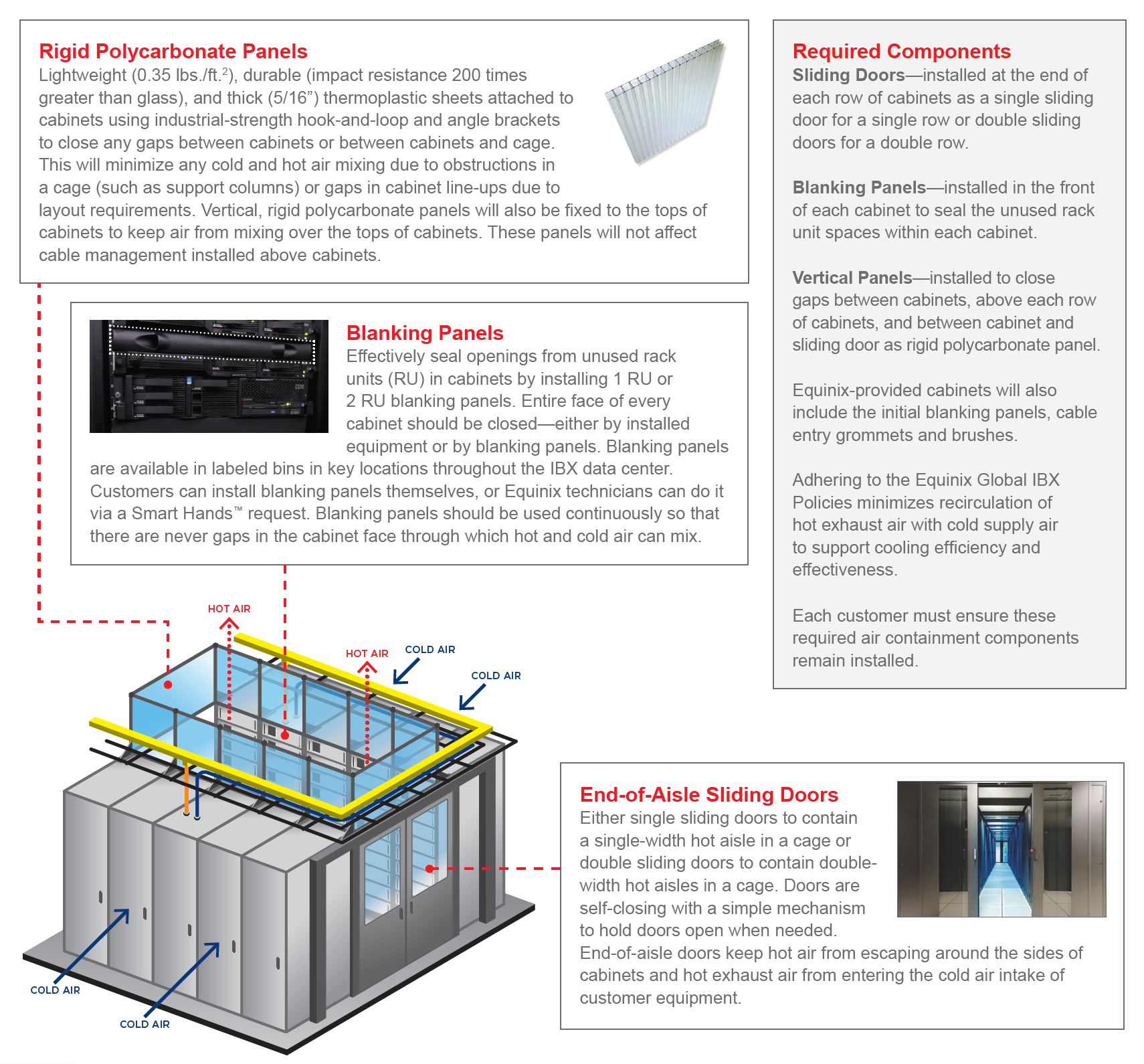
For more information, refer to our Customer installation Guidelines.
Air Containment Audits
Equinix performs audits periodically to:
- Ensure compliance with airflow management policies.
AND
- Verify that containment components are installed and functioning as intended.
If a technician needs to enter your cage to perform an audit, Equinix will first request your permission to access your cage.
For specific policy information, refer to the following sections of our Global IBX Policies:
- Section D.6. (Customer’s Equipment—Installation and Operation)
- Section D.9. (Environmental)
If you receive a policy enforcement notification from Equinix, refer to the Airflow Management Policy FAQ.
To request an audit of your space, submit a Smart Hands order and choose order type Physical Audit, or ask the Global Service Desk (GSD) to submit the order on your behalf. You can also use Smart Hands if you need Equinix to rectify any air containment issues in your space.
Liquid Cooling
Equinix offers the following liquid cooling solutions.
Liquid to Cage Offering
The Equinix liquid-to-cage product offering provides the following features:
- Standardized deployment configurations for your direct-to-chip hardware
- Enable both liquid-cooled and air-cooled hardware from a single environment
- Equinix solution collaboration with your preferred OEM & liquid cooling vendor
- Bring your own CDU and connect directly to Equinix facility water supply
- Compatible with most direct-to-chip OEM hardware
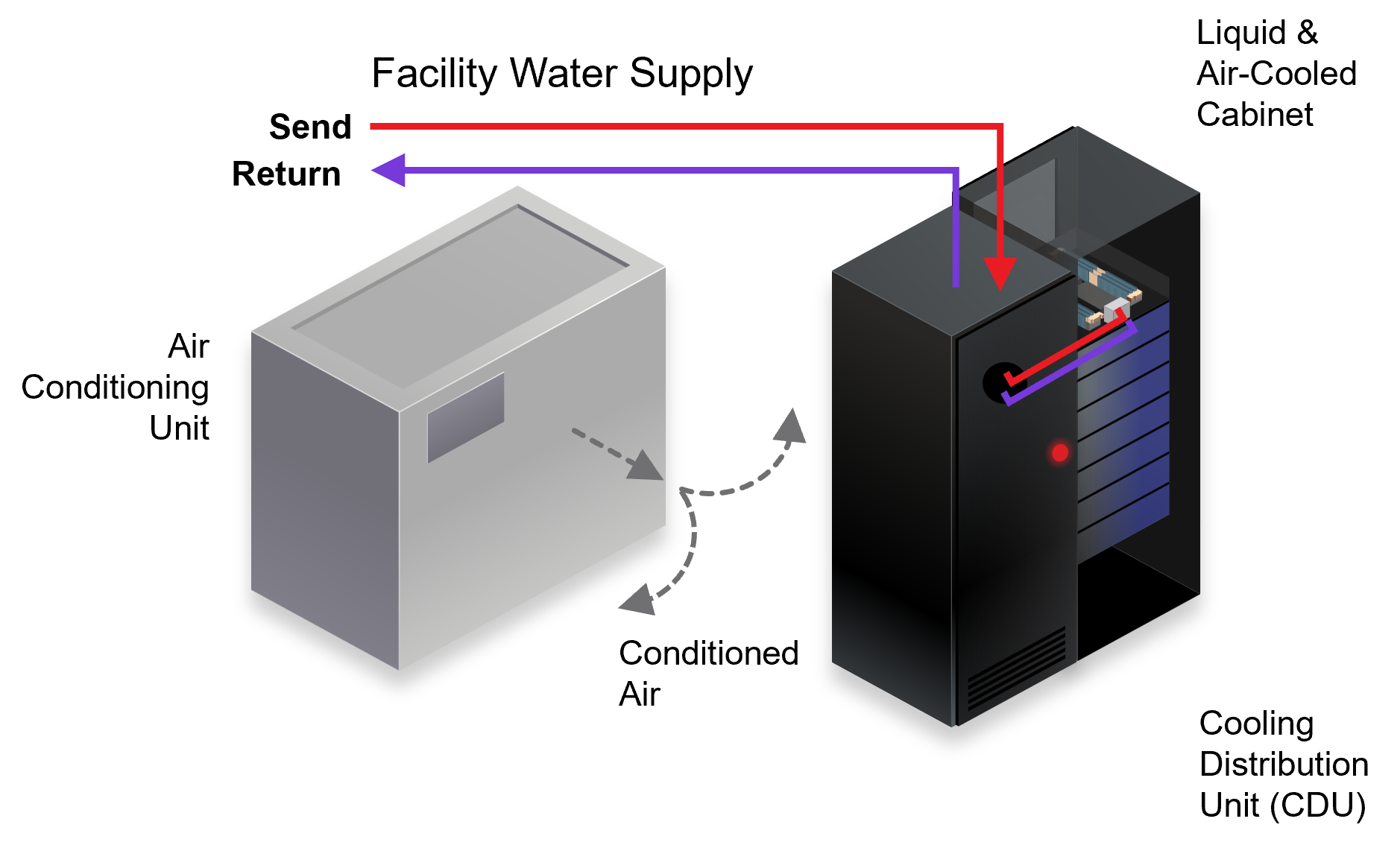
Liquid to the Cage:
- Liquid circuits deliver controlled water flow to your cage
- Primary tap off point to CDU as the liquid demarcation point
- Bring your own CDU or purchase from Equinix
Flexible Engagement Models:
- Equinix standard Smart Build design packages
- Cooling Vendor or OEM assisted
- Customer self-build
Liquid-ready:
- Standardized for direct-to-chip liquid cooling
- Rear-door heat exchangers available at select locations
- Industry-leading cage containment and leak detection
Liquid Cooling Smart Build:
Work with our trusted experts to build out your secondary cooling loop and liquid-cooled cage design.
Liquid to Air Direct to Chip
If you have a private cage, liquid cooling equipment may be allowed in your colocation space to support next-generation processors that require liquid cooling for optimal performance.
A liquid-to-air heat exchanger is a device used to dissipate the heat generated by electronic equipment. The heat exchanger circulates a cooling liquid (such as water or refrigerant) through a heat-transferring surface in close proximity to the equipment. The heat is transferred from the equipment to the liquid, which then carries the heat back to the heat exchanger, where it is dissipated into the air by a fan.
With direct-to-chip (D2C) cooling, the heat-transferring surface operates on or near the surface of the silicon chip. This maximizes heat dissipation, allowing processors to operate more efficiently than those cooled by air-to-air heat exchange.
Requirements:
-
Your colocation space must be a private cage (not a shared space).
-
You must provide the in-rack cooling equipment. It must be a self-contained liquid-to-air heat exchanger that sits inside the cabinet and does not pass coolant liquid to other cabinets.
-
The equipment must use non-flammable, non-combustible coolant such as DI treated water or PG25.
-
You must provide to Equinix:
- The spec sheet and manual for your liquid-to-air (L2A) heat exchanger.
- The Safety Data Sheet (SDS) for the coolant.
If you can meet the requirements above, contact your CSM or Sales Engineer to review and sign the terms and conditions for using liquid cooling in your cage.
If you do not meet the requirements above, contact us to discuss other liquid cooling solutions.